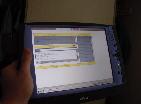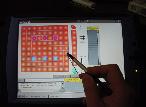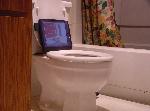

The new toy that I have showing in these photographs is called the X-pilot, manufactured by a company called AboCom in Taiwan. It has an Intel StrongArm SA-1110 CPU @206 MHz, 64 MB of DRAM, 32MB of onboard Strata Flash. I also added a 256MB compact flash storage card to it (plugged in at the top of the device, hence not visible). It also has a type II PCMCIA slot on the left, in which I plug in a IEEE 802.11b wireless LAN card (manufactured by another Taiwanese company called ZCOM). The touch screen is a great-looking 10 inch LCD with 800x600 resolution at 8-, 16-, 24-, and 32-bit settings!
The X-pilot runs Windows CE 3.0 and I am unsure what version its bundled Internet Explorer is. There's a good hand-writing recognition software called the Calligrapher that I installed and it allows the user to simply write normal sentences (without the need to pause at each letter) and fairly accurately converts it into string format and feeds it to the running application.
In order to run the OCTI online Java applet, the browser needs a Java Virtual machine. In this case, the X-pilot uses Insignia Jeode as the VM. As you can see in the photographs below, it works! (well, first time around it crashed the system...) As to the performance of the application running on this device, it is not very fast, but tolerable. Afterall, Java is a big memory clogger, not to mention that it's always slow compared to native binary codes. This is ESPECIALLY true when it comes to embedded devices. Even though I had planned to finish up my own OCTI player implementation and make it run on desktops and embedded devices, I had not been able to do it due to no time outside of my work... I can only pray that in the near future I'd get some freetime to do something about it.
Anyway, now, if I have (ever so very little) break time to play OCTI, I can do it in the living room, on the bed, or even while I am working hard in the bath room!!!! I love this device!
PS: In fact, it can play wherever there's a WLAN access point signal. I've been using it in restaurants where in its neighbourhood there are people running APs and I'd share (steal) the bandwidth happily. I haven't tried it out in airports yet, but I think some airports also support wireless (IEEE 802.11b or bluetooth) devices. Didn't Starbucks say that they were going to install one at every one of their stores too?!


 Click to Enlarge.
Click to Enlarge.
Copyright ¨ 2001-2003, SELFSO.COM . All Rights Reserved. |